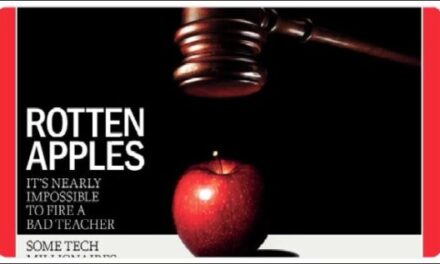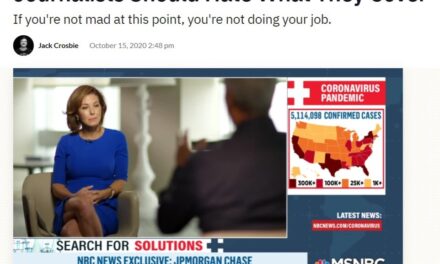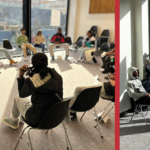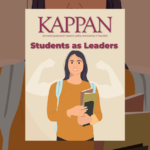The latest New Yorker interview suggests promising ways journalists can gather useful information from the often-interviewed teachers union head.
By Alexander Russo
On Friday, the New Yorker published a new interview with American Federation of Teachers president Randi Weingarten, described as “one of the most important voices on organized labor in the United States.”
Titled Randi Weingarten on Opening Schools Safely, the interview by staff writer and chief interviewer Isaac Chotiner features a series of questions about teachers unions’ much-discussed role in school reopening.
“As state and local governments have pressed school districts to resume in-person education despite the coronavirus pandemic, teachers’ unions have resisted a return to school buildings without further assurances of their members’ safety,” notes Chotiner’s introduction.
Disclosure: The American Federation of Teachers helped fund The Grade’s first-year launch.

My first reaction to the piece was that it was another in a long line of instances in which major news outlets have given Weingarten a free pass to say pretty much whatever she wants to say, without much accountability.
The piece seemed better than the New York Times’ puff piece earlier this winter, but not by much.
Two days later, however, I think my initial assessment was wrong. The New Yorker interview is muted and a bit coy for my tastes and has at least one serious flaw. But it illustrates effective strategies that journalists and news outlets can use to provide better information for readers when featuring Weingarten and others like her.
By inserting clarifying statements in the middle of Weingarten’s responses, using previous quotes and promises, and circling back repeatedly to a central theme, the New Yorker interview contextualizes Weingarten’s responses, pressures the union leader to explain herself clearly, and reveals useful new information.
It’s a good interview, and its strategies are ones that other reporters could use.

INSERT CONTEXTUAL INFORMATION
In several places, the New Yorker interview inserts the notes from government officials and experts in the middle of Weingarten’s lengthy answers.
For example, a note inserted in the middle of Weingarten’s response questioning the CDC’s research features a quote from one of the researchers who wrote the guidance:
“Our study was done in an area and time with high community spread. There have been studies across the country in areas with a high density of students, and in areas where ventilation was not upgraded.”
These italicized quotes from government officials signal to readers that Weingarten’s responses are not necessarily complete and provide important context to her answers.
It’s too bad that the same strategy isn’t used to clarify Weingarten’s claim that she and her union have been pro-reopening “since last April,” an oft repeated but misleading statement that is yet again allowed to stand unchallenged.
But inserting contextual information is a valuable strategy that that reporters can and should do.
ASK QUESTIONS BASED ON PAST QUOTES
At several points, the New Yorker’s Chotiner questions Weingarten’s use of past quotes to press a point.
He cites her New York Times response to the CDC’s reduced social distancing requirement from six feet to three, in which she complains that “miraculously there’s now studies that say three feet are fine.”
He presents her with her statement in the Post, in which she decries a situation in which the recommendations are being changed “in order to squeeze more kids into schools.”
This strategy — common in political reporting — calls public figures to account for past statement, gives readers important context, and sometimes generates valuable new information.
In the interview’s concluding exchange, Weingarten is asked about her previous plans for a big speech “telling teachers that it can be safe to return to work.”
Weingarten reveals that the speech is still planned — but that it will focus on getting teachers to return for the start of the 2021-22 school year, not before the end of this one.
CIRCLE BACK TO THE CENTRAL THEME (LIKE OPRAH)
In a relatively short interview, Chotiner isn’t afraid to circle back to an important topic that hasn’t yet been addressed to his satisfaction.
Starting in the introduction and throughout the interview, Chotiner repeatedly returns to the central issue of trust.
I count at last six instances in which he uses words like trust, mistrust, or distrust. For example:
“Does giving quotes like this undermine trust?”
“I was just wondering if you thought that sometimes the message from you or the A.F.T. made people distrustful of the possibility of coming back safely.”
With this approach, the journalist signals to readers the central theme of his interest and forces his interview subject to respond to a central question in different ways, exposing different facets of her thinking and actions.

These three strategies — inserting contextual information, using past quotes, and repeating variations on a central question — show how journalists can produce useful information from interviews with challenging interview subjects.
None of them requires extensive knowledge or taking a combative attitude toward the subject.
I hope that reporters who interview Weingarten going forward will give these a try.
Related from The Grade:
Covering teachers unions and strikes
ABOUT THE AUTHOR

Alexander Russo
Alexander Russo is founder and editor of The Grade, an award-winning effort to help improve media coverage of education issues. He’s also a Spencer Education Journalism Fellowship winner and a book author. You can reach him at @alexanderrusso.
Visit their website at: https://the-grade.org/













